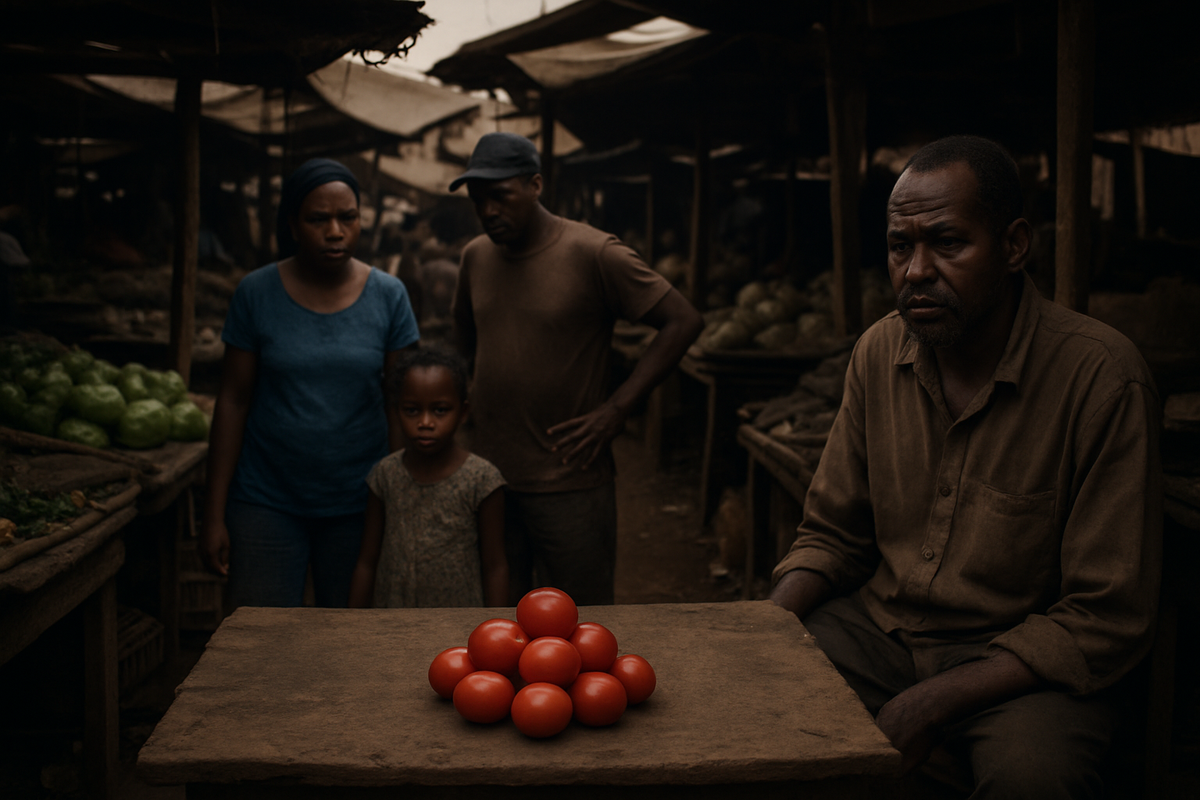
Yaoundé, Cameroon – October 21, 2025 – The capital city of Cameroon, Yaoundé, is currently reeling from an unprecedented and severe shortage of fresh tomatoes, sending prices soaring to exorbitant levels. This crisis has transformed a once-staple ingredient into a luxury, placing an immense financial burden on already struggling households and raising significant concerns about national food security and economic stability.
The immediate implications are dire for the average Cameroonian family. With the cost of even a few tomatoes becoming prohibitive, many are forced to drastically alter their diets, resorting to less preferred canned or bagged alternatives. This shift not only impacts traditional cuisine but also raises questions about nutritional intake, threatening to widen food consumption gaps and potentially increase malnutrition levels across the country.
Detailed Coverage of the Crisis
The current tomato crisis, intensifying in October 2025, is a culmination of several critical factors. In Yaoundé's markets, the price of just two small tomato fruits can fetch 100 CFA francs, while a single crate now ranges between 12,000 and 15,000 CFA francs—more than double its usual cost. This dramatic surge is primarily driven by soaring agricultural input costs, adverse climatic conditions, and persistent disruptions within the food supply chain.
Farmers report that the cost of essential agricultural inputs, such as fertilizer, has quadrupled, jumping from 3,000 CFA francs to 13,000 CFA francs. This exponential increase makes it increasingly difficult for producers to cultivate tomatoes profitably. Compounding this challenge are the severe effects of global warming, which have led to erratic rainfall patterns; farmers initially faced insufficient rain for planting, followed by excessive downpours that caused crops to rot. These climatic shocks have resulted in significantly meager harvests. High post-harvest losses, estimated between 15-35% for perishable goods like tomatoes, further exacerbate the shortage due to inadequate storage and transportation infrastructure, preventing produce from reaching markets efficiently.
The timeline of this crisis can be traced back to a confluence of these long-standing issues. General inflationary pressures have seen Cameroon's cumulative inflation reach 19.3% between 2022 and 2024, with food and transport costs being primary drivers. Food products alone experienced an 11.1% price increase in 2023. Furthermore, protracted conflicts in Cameroon's Northwest, Southwest, and Far North regions have severely impacted agricultural production and disrupted supply chains. Anticipated separatist-imposed lockdowns in October 2025, intended to boycott presidential elections, are expected to further exacerbate these supply issues, limiting market access and increasing prices.
Key stakeholders involved include the smallholder farmers grappling with production challenges, distributors facing higher procurement costs and logistical hurdles, and consumers bearing the brunt of inflated prices. The Cameroonian government is also a critical player, tasked with ensuring food security and managing inflation. Initial market reactions have seen a scramble for alternatives, with a noticeable shift towards processed tomato products, reflecting the desperation of households to maintain some semblance of their traditional diets.
Impact on Public Companies and Stakeholders
The soaring tomato prices and acute shortage in Cameroon have created a complex landscape for businesses across the agricultural and food sectors, presenting both challenges and unexpected opportunities.
Companies involved in agricultural inputs, such as fertilizers, seeds, and pesticides, face a nuanced situation. While the quadrupling of fertilizer prices burdens farmers, it also highlights a potential for increased demand if government initiatives or farmer cooperatives actively seek to boost production. Suppliers of climate-resilient seeds or pest control solutions could see a rise in demand, particularly if the government implements robust support programs. However, if farmers abandon tomato cultivation due to persistent losses, the demand for these inputs could diminish.
The most significant beneficiaries appear to be food processing companies. With fresh tomatoes becoming a luxury, consumers and businesses are increasingly turning to processed alternatives like tomato paste, puree, and canned goods. Local Cameroonian companies like Delifood Agroindustries Sarl and Société de transformation des produits d'élevage et d'agriculture du Sahel (Sotreas), which have announced investments in tomato processing plants, are well-positioned to capitalize on this shift. Regional agri-food giants like SOTIGROUP (which includes Soticam in Cameroon), known for its "Mamy" brand tomato paste, are also likely to experience increased demand for their products, thereby stabilizing their market presence and potentially boosting revenues. These companies offer a vital buffer against the volatility of fresh produce, providing a more consistent and often more affordable option.
Conversely, food distribution companies heavily reliant on fresh produce, especially fresh tomatoes, are likely to face significant losses. Reduced volumes, higher procurement costs, and challenges in maintaining consistent supply lines due to road conditions and conflict will squeeze their margins. Small-scale traders and local market vendors are particularly vulnerable, struggling to absorb the increased costs. Larger international distributors, such as Olam Agri, a key player in Cameroon's agri-business, might be able to adapt by diversifying their offerings or increasing imports of processed goods, leveraging their extensive networks to mitigate the impact. Retailers, including supermarkets, will also struggle with higher purchasing costs and potential stockouts for fresh tomatoes, although those that quickly pivot to offering a wider range of processed alternatives might fare better.
Wider Significance and Systemic Challenges
The tomato crisis in Cameroon is far more than a simple agricultural hiccup; it is a stark symptom of deep-seated systemic vulnerabilities within the nation's agricultural sector and broader economy, amplified by global trends.
This event is intimately linked to broader agricultural trends, particularly the severe impact of climate change on Cameroon's predominantly rain-fed agriculture. Erratic rainfall, including both droughts and floods, is disrupting planting cycles, slashing crop yields, and fostering conditions for pests and diseases. The destruction of vast farmlands by flooding, as seen in the Far North region in 2024, highlights the fragility of the food system. This dependency on unpredictable weather, coupled with outdated farming methods, severely limits farmers' ability to adapt. Furthermore, significant post-harvest losses (15-35%) due to poor infrastructure and high temperatures underscore critical weaknesses in the supply chain, while ongoing conflicts in the Northwest, Southwest, and Far North regions further impede production and market access. The crisis is a potent indicator of worsening food insecurity, with millions projected to face acute food insecurity, exacerbated by high staple food prices and leading to wider food consumption gaps and rising malnutrition.
The ripple effects of the tomato crisis are already being felt across the economy. The surge in agricultural input costs, exemplified by quadrupled fertilizer prices, directly impacts the production costs of other crops, threatening to drive up prices for a wider array of food items. Food prices in January 2025 were already 7.90% higher than the previous year, with vegetables contributing significantly. This places immense pressure on consumer spending, forcing households to adopt negative coping strategies like skipping meals. Economically, high food inflation contributes to overall inflation (4.5% in 2024, above the CEMAC threshold), making the government's 2025 target of 4% inflation challenging. Weak economic growth, combined with rapid population increases, exacerbates poverty, with extreme poverty potentially affecting 8 million people by 2026.
In terms of regulatory and policy implications, the Cameroonian government has historically implemented measures like cereal export bans, subsidies, tax exemptions, and price controls for staples. However, the persistent rise in food prices suggests that these interventions often fall short of addressing root causes. There is an urgent call for more robust agricultural support programs, including subsidized inputs, investment in infrastructure (like the rehabilitation of over 1,800 km of rural roads since 2021), and climate-resilient farming practices. The 2020-2030 National Development Strategy (SND30) aims to reduce import dependence, emphasizing the need for domestic production of farm inputs to mitigate vulnerability to global disruptions.
Historically, Cameroon has experienced persistent food insecurity and price volatilities, mirroring broader patterns in Sub-Saharan Africa. The 2007-2008 global food crisis and the COVID-19 pandemic, which saw staple food prices surge by nearly 20% in local SSA markets, serve as precedents. These events highlight recurring patterns: vulnerability to external shocks (global fuel and fertilizer prices), the devastating impact of internal conflicts, chronic climate dependency, and infrastructure deficiencies leading to high post-harvest losses. Lessons learned underscore the critical need for strengthening domestic food production, diversifying crops, adopting climate-resilient practices, and investing in agricultural infrastructure to build long-term resilience and move beyond short-term, often ineffective, interventions.
The Road Ahead: Short-term and Long-term Outlook
As Cameroon navigates the ongoing tomato crisis, both immediate and long-term strategies are crucial to stabilize the market and ensure food security. In the short term, consumers will continue to adapt by seeking cheaper alternatives, including processed tomato products. The government may revisit market regulation and price monitoring to curb excessive speculation, though such measures often have limited long-term impact on production. Regional trade dynamics might shift, with Cameroon potentially controlling exports more strictly to prioritize domestic supply. However, the period around the October 2025 presidential election could heighten political tensions and further disrupt supply chains in conflict-affected regions, exacerbating food insecurity. While some seasonal price stabilization might occur in southern areas, overall prices are expected to remain above average.
Looking further ahead, a comprehensive, multi-pronged approach is essential. Government strategies, as outlined in Cameroon's long-term agricultural policy, aim to boost productivity through initiatives like the Central Plain Project to develop vast arable land and the rehabilitation of rural roads to improve market access. Investments in agricultural storage warehouses, including those for onions, are planned to reduce post-harvest losses. Critically, the National Agricultural Guarantee Fund, launched in 2022, seeks to improve farmers' access to credit, enabling greater investment in inputs and technology. Climate-resilient agriculture is a key focus, with projects promoting improved crop varieties, efficient water management (e.g., small-scale irrigation), and early warning systems for climate extremes. The government's 2020 plan to revive the tomato sector, focusing on enhancing technical capacities and input access, will also need renewed emphasis.
Farmers, in turn, must adapt by adopting climate-resilient practices, such as using heat-tolerant seeds and integrated soil fertility management. Strengthening farmer cooperatives can facilitate collective action in acquiring inputs, accessing markets, and utilizing shared storage and processing facilities. Consumer habits may also shift permanently towards diversified diets and increased demand for locally processed tomato products, provided quality and taste preferences are met.
Strategic pivots are needed across the value chain. The agricultural sector must transform towards agro-industrialization, emphasizing value-added products and sustainable practices. Modernization of food distribution requires urgent investment in cold storage and solar-powered mobile cooling units to drastically reduce post-harvest losses, which can reach 40% for perishables. Developing local processing capacity, though challenging due to raw material consistency and energy use, presents a significant opportunity to stabilize prices, reduce waste, and create new market outlets for farmers. Market opportunities exist for investment in climate-resilient farming technologies, improved logistics, and agri-entrepreneurship. However, persistent challenges include high input costs, climate volatility, ongoing insecurity, and limited access to modern technology for smallholder farmers.
Potential scenarios for the coming years range from gradual improvement, driven by government investments in infrastructure and climate adaptation, to a continued crisis if underlying issues are not adequately addressed. An optimistic scenario involves accelerated transformation through concerted government action, substantial private sector investment, and robust international partnerships, leading to stable production, lower prices, and enhanced food security. The future of Cameroon's tomato crisis hinges on effective policy implementation, rapid climate adaptation, and sustained political will.
Conclusion: Navigating the Tomato Crisis
The soaring tomato prices and acute shortage in Cameroon's capital represent a critical juncture for the nation's food security and economic stability. This crisis is a potent manifestation of a complex interplay of factors: the escalating costs of agricultural inputs, the undeniable impacts of climate change on rain-fed agriculture, structural weaknesses in supply chains, and the disruptive influence of protracted regional conflicts. For households, the immediate burden is immense, forcing dietary compromises and deepening financial strain.
Looking forward, the market faces continued volatility in the short term, especially with political tensions potentially exacerbating supply issues. However, the long-term outlook presents opportunities for systemic change. Key takeaways emphasize the urgent need for comprehensive government strategies focused on agricultural modernization, including robust support for climate-resilient farming, significant investment in post-harvest infrastructure like cold storage and processing plants, and improved access to credit for farmers. The rise of local food processing companies like Delifood Agroindustries Sarl and SOTIGROUP (through Soticam) offers a viable pathway to stabilize supply and mitigate price shocks.
Moving forward, investors should closely watch the implementation of agricultural reforms and infrastructure projects, particularly those aimed at reducing post-harvest losses and enhancing processing capacity. The commitment to climate-resilient agriculture and the effectiveness of government interventions in stabilizing input costs will be crucial indicators. The ability to foster public-private partnerships and attract investment into the agricultural value chain will determine Cameroon's success in building a more resilient and food-secure future. The current tomato crisis serves as a powerful reminder of the interconnectedness of environmental, economic, and social factors, demanding integrated and sustainable solutions.
This content is intended for informational purposes only and is not financial advice





